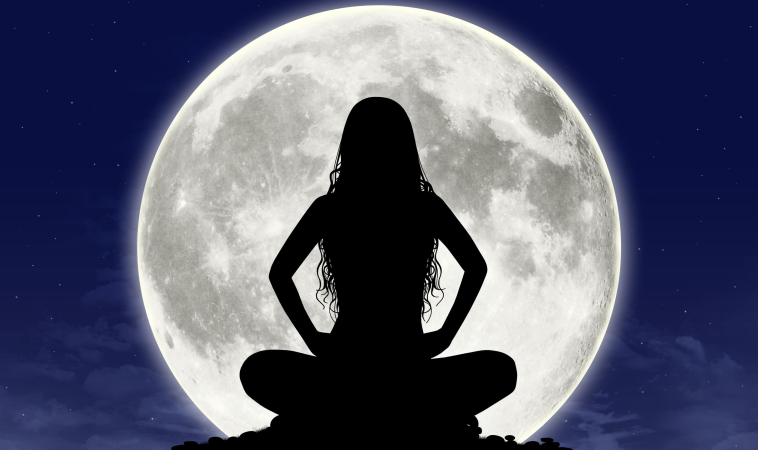The cycles of nature are magical and mysterious. The world around us shows many examples of patterns that are cyclical in nature: The moon orbits the earth and as the earth rotates, it also orbits the sun. This gives us day/night cycle known as the circadian cycle as well as the light and weather patterns we call seasons. This process impacts us biologically in many ways and most familiar is the circadian rhythm of the sleep/wake cycle, but there is much more to it! Circadian rhythms regulate many functions such as migration, hibernation, and reproduction in plants and animals. Plants learn what season it is through these circadian rhythms and the migratory pattern of monarch butterflies is led by them. In humans, many hormonal processes are regulated by these changes in light and temperature. The female reproductive cycle, and more specifically, menstruation is a beautiful example of how intrinsically we are connected to our environment.
Women’s Cycle Correlates to Moon Cycles in Absence of Electric and Artificial Light
Month after month, a woman’s menstrual cycle mirrors the moon cycle, which coincidently has an average length of 29.5 days as well. Similar to the moon cycle, a woman’s menstrual cycle changes from the “menstruation of new growth, to the ovulation of full power and blossom, to the pre-menstrual phase of harvest and degeneration, and back to menstruation of renewal again.”(1) The natural cycle of women who live and sleep out in the open away from artificial light is to ovulate on the full moon and menstruate on the new moon; however, this is not the case for most contemporary women whose natural cycles are largely affected by artificial light. A recent study, The regulation of menstrual cycle and its relationship to the moon, analyzed 826 women, aged 16-25, and how their menstruation cycles related to moon cycles. It found that only 28% of women menstruated around the new moon.(2) Due to the fact that moonlight inhibits melatonin and interferes with estrogen receptors, high melatonin during a new moon means less estrogenic effects or the beginning of a menses and low melatonin leads to higher estrogenic effects which are common near ovulation. Sleeping in the absence of electric and artificial light does not only create a natural, healthy menstruation cycle, but also has numerous benefits for women. These benefits include reversing anovulatory cycles, creating healthy FSH levels, generating average length cycles for women with irregular periods, reducing spotting, strengthening progesterone levels and so much more.(3) Removing artificial and electric lighting from affecting your sleep patterns will create a natural, regular menstruation cycle and empower you to feel like the strong, healthy woman that you are.
Traditional Ways Women Honored the Menstrual Cycle
Women have come a long way in the knowledge and approach of menstrual cycles. However, throughout time, we have lost the simplicity and tradition in how our ancestors celebrated this time of month. In Reclaiming the Power of Blood, naturopathic doctor Kristina Conner writes, “In many native cultures, women were often separated during menstruation, forbidden to perform household tasks or communicate with other group members. It was considered natural, but also mysterious, foreign and sometimes dangerous.”(4) Although women were separated from others, it was not a punishment, but often a reverence. Some tribes often thought women to be the embodiment of a holy person during their periods as their other worldly powers stemmed from their ability to bleed profusely without dropping dead. During their menstrual cycles, Native American women would go into moon lodges with other women and tell stories, do crafts, vision and attain guidance and celebrate renewal. Shamans believe their special powers are heightened during menstruation and were separated into a menstrual hut.(5) This was truly a sacred time for a woman to tap into her feminine power, fertility, creativity and nurturing spirit. The menstrual cycle is about women’s energy and power; the power to be, to restore, to receive and to create. Although current culture keeps menstruation a hush matter, tradition proves it to be a time of power and awakening.
Symbology of the Cycle (Release, Cleansing, Letting Go of Potential Life, Renewal, Fertility)
In Shaman culture, the menstrual cycle comes in four phases-menstruation, pre-ovulation, ovulation and pre-menstruation.(6) Menstruation, also known as The Winter or dark/new moon, is time for a woman to bring focus onto herself. Winter solstice is the darkest part of the year, which only makes sense that winter represents the darkest part of the menstrual cycle. Although this is the most painful of the four phases, it is important for a woman to honor herself and nurture her body. Pre-ovulation, also known as The Spring or waxing moon, is a time of new growth. As the Spring Equinox brings us promise and the Earth is waking up, a woman’s body promises fertile and energy to nurture innovative growth. During this phase, women experience energy to begin projects, mature ideas and begin planning ahead. Ovulation, also known as The Summer or full moon, is a time to manifest. As the Sun returns to Earth, a woman’s body is highly fertile, open and ready to create. As the Summer Solstice is time to go outside and soak in the Sun, this phase encourages social interaction and grounding. Pre-Menstruation, also known as The Autumn or waning moon, is a time of harvest and withdrawal. During this phase, a woman can often become exhausted as her energy is turned inward to prepare for menstruation. This is often a time for emotional hardships and slowness. In this way, through the symbolism of menstruation, women can somatically express many of their psycho-sexual and emotional issues. It is important for women to understand that the menstrual cycle is more than just one unfortunate week a month; it is symbolically the basis of our femininity.
Intuition during Menses or “Moon”
The menstrual cycle governs the flow of not only blood, but of information and creativity. We receive and process information differently at different times in our cycle. In Wisdom of the Menstrual Cycle, Christiane Northup, MD, explains, “Despite the emergence of patriarchal viewpoints, many women still experience deep, profound spiritual connections when bleeding however, majority of the Western world suppress their blood flow, blocking their creative intuition and refusing to honor this divine time. Since our culture generally appreciates only what we can understand rationally, many women tend to block at every opportunity the flow of unconscious “lunar” information that comes to them premenstrually or during their menstrual cycle. ”(7) Lunar information is reflective and intuitive. It comes to us in our dreams, our emotions, and our hungers. It comes under cover of darkness. By syncing their menstrual cycles to the moon cycle, women can benefit greatly by tuning into their menstrual intuition and empowering their bodies.
Feminine Wisdom, Second Chakra, First Environment of Life, Rich in Mesenchymal Stem Cells
The second chakra, also known as the Sacral Chakra or Svadhisthana, is your pleasure and passion center. Located in the pelvic area, the gift of this chakra is experiencing our lives through feelings and sensations. The Sacral Chakra also governs our reproductive organs and related emotions, sexual libido, desire, and creative energy. It corresponds with our emotions, hormone balance, and mood; so, it only makes sense that keeping your second chakra balanced will maintain a healthy menstruation cycle. An imbalanced sacral chakra is known to cause excessive or missed menstrual cycles. In her book Anatomy of the Spirit: The Seven Stages of Power and Healing, author Carolyn Myss, Ph.D., explains that many female health problems come from an imbalanced second chakra. She writes that “problems with menstruation, cramps and PMS are classic indications that [a woman] is in some kind of conflict with being a woman. Problems with bleeding or irregular periods frequently occur due to emotional stress and the feeling that a woman doesn’t have control over her choices and balancing the second chakra will avoid this.”(8) Keeping your Svadhisthana balanced and healthy will ultimately benefit your menstrual cycle and keep your period healthy. Maintaining a healthy menstrual cycle is beneficial for staying rich in mesenchymal stem cells. A recent study, Growth Kinetics, Characterization, and Plasticity of Human Menstrual Blood Stem Cells, found that “Menstrual blood has been considered one of the most accessible sources for obtaining MSCs noninvasively. Recently, there has been a great deal of interests in the application of these cells in regenerative medicine due to their multilineage and highly proliferative features. Men-SCs have been introduced as a good source of cell transplantation for various therapeutic procedures such as the treatment of premature ovarian failure.”(9) Increasing your knowledge of how to keep a healthy menstruation cycle and why it is beneficial for becoming rich in mesenchymal stem cells will not only benefit you, but others as well.
Symbolism of Letting the Blood Flow versus Stopping It
Understanding the way of menstruation cycles brings with it an awareness of the flow of energy, the wisdom in that flow and the opportunity to be in synchrony with that flow. By embracing your menstrual cycle and allowing yourself to embrace the flow, you are building your energy levels and taking advantage of what your body has to offer. In an excerpt from The Female Sexual Organs: Shape, Function, Symbol and Archetype, Nelson Soucasaux, Brazilian gynecologist, writes, “Given the enormous emotional and archetypal importance of the genitals, bleeding originating from these organs – even physiological, as menstruation – end by acquiring a very special symbolism. The menstrual bleeding is always endowed with a powerful symbolic force. Because of this, as I always used to remark, women can somatically express many of their emotional problems through the symbolism of menstruation.”(10) It is very important and healthy for women to use the time during blood flow to connect to their body’s needs and energies.
Eco Impact of Disposable Hygiene Products (Landfills/Glyphosate)
In the book Flow: The Cultural Story of Menstruation, the author summarizes that the average woman disposes of around 300 pounds worth of disposable feminine hygiene products in a lifetime. In the United States alone, an estimated 12 billion pads and 7 billion tampons are disposed of annually. Each of those tampons and pads has an environmental impact of the waste of not only the product itself, but the packaging, plastic or cardboard applicators, as well as the less visible costs of transportation and production.(11) In addition to having a destructive impact on landfills, it is being recognized that feminine hygiene products contain glyphosate. Glyphosate is a broad-spectrum systemic herbicide and is most recognized as a weed killer. A new study at The University of La Plata, in Argentina, found that “about 85% of cotton products, such as feminine products like pads and tampons, tested positive for glyphosate and 62% of the products had traces of AMPA, an environmental metabolite aminomethylphosphonic acid that is a derivative of glyphosate and is potentially one thousand times more toxic than glyphosate.”(12) Although our periods are having a negative impact on our bodies and landfills, there are many eco-friendly products hitting the market. Using organic feminine hygiene products keep glyphosate out of our bodies and menstrual cups, like the diva cup, and reusable pads keep our carbon footprint at a minimum while we embrace our menstrual cycles.
A Culture That De-Feminizes Women, Looks for Ways to “Stop the Flow” Taking Hormones to Stop or Lessen the Period
There actually are medical ways to stop your period. You can take birth control continuously so that you skip the bleeding week, or get the Depo Provera shot, which simulates menopause in your body. Neither option comes without risks. When you take external hormones, you may feel temporary relief but may be contributing to longer term issues. The Mayo Clinic advises that, “weight gain, depression, and migraines are a few of the regularly occurring side-effects of these drugs. Interrupting your natural hormonal cycle is confusing to your delicate endocrine system and when the time comes that you must come off of the medication, your body will be left even more confused than it was.”(13) In addition to being bad for your health, stopping the natural menstrual flow is an act that defeminizes women. Throughout the entirety of this blog, it is learned that the menstrual cycle is more than just one unfortunate week a month. Menstrual cycles are not meant to be unnaturally stopped or controlled with medications. Menstruation is the basis of femininity, and embracing our cycles will empower the female population. The closer we adhere to and embrace the wisdom of nature, the healthier we are for it.
 Razi Berry, Founder and Publisher of Naturopathic Doctor News & Review (ndnr.com) and NaturalPath (thenatpath.com), has spent the last decade as a natural medicine advocate and marketing whiz. She has galvanized and supported the naturopathic community, bringing a higher quality of healthcare to millions of North Americans through her publications. A self-proclaimed health-food junkie and mother of two; she loves all things nature, is obsessed with organic gardening, growing fruit trees (not easy in Phoenix), laughing until she snorts, and homeschooling. She is a little bit crunchy and yes, that is her real name.
Razi Berry, Founder and Publisher of Naturopathic Doctor News & Review (ndnr.com) and NaturalPath (thenatpath.com), has spent the last decade as a natural medicine advocate and marketing whiz. She has galvanized and supported the naturopathic community, bringing a higher quality of healthcare to millions of North Americans through her publications. A self-proclaimed health-food junkie and mother of two; she loves all things nature, is obsessed with organic gardening, growing fruit trees (not easy in Phoenix), laughing until she snorts, and homeschooling. She is a little bit crunchy and yes, that is her real name.
References:
- Jing J., 2013. The Moon Cycle and The Menstruation Cycle. http://www.cycleharmony.com/stories/menstrual-myths-a-rituals/the-moon-cycle-and-the-menstrual-cycle
- Law SP. The regulation of menstrual cycle and its relationship to the moon. http://www.ncbi.nlm.nih.gov/pubmed/3716780
- Terra, 2013. Match Your Cycle to the Moon- Menstrual Sutra #7. http://relaxmenstrualcramps.com/category/moon-and-menses/
- Editor, 2007. Reclaiming the Power of Blood. https://ndnr.com/womens-health/reclaiming-the-power-of-blood/
- Katherine Smith, 2014. The Secret Power of Your Period Revealed. http://mytinysecrets.com/the-secret-power-of-your-period-revealed/
- Cat Stone, 2012. The Magic of the Menstrual Cycle. http://naturalshaman.blogspot.com/2012/06/magic-of-menstrual-cycle.html
- Christiane Northup, 2015. Wisdom of the Menstrual Cycle. http://www.drnorthrup.com/wisdom-of-menstrual-cycle/
- Cathleen McCauley, 2011. Foundation and Femininity: Healing the First and Second Chakras. http://www.pullingdownthemoon.com/blog/2011/march/foundation-and-femininity-healing-the-first-and-.aspx
- Davood Mehrabani, PhD, Roshanak Bahrami Nazarabadi, MS, Maryam Kasraeian, MD, Amin Tamadon, PhD, Mehdi Dianatpour, PhD, Akbar Vahdati, PhD, Shahrokh Zare, BS, and Farnaz Ghobadi, 2016. Growth Kinetics, Characterization, and Plasticity of Human Menstrual Blood Stem Cells. http://www.ncbi.nlm.nih.gov/pmc/articles/PMC4764963/
- Nelson Soucasaux, 2012. Psychosomatic and Symbolic Aspects of Menstruation. http://www.mum.org/psychos.htm
- Rachel Tamigniaux, 2010. The Environmental Impact of Everyday Things. http://www.thechicecologist.com/2010/04/the-environmental-impact-of-everyday-things/
- Alex Pietrowski, 2016. Monsanto’s Chemicals Make Their Way Into 85% of Personal Hygiene Cotton Products. http://www.wakingtimes.com/2016/01/12/monsantos-chemicals-makes-their-way-into-85-of-personal-hygiene-cotton-products/
- http://www.mayoclinic.org/diseases-conditions/chronic-daily-headaches/in-depth/headaches/art-20046729


















I love it when it’s related to chakras. It feels like the pain is worth it because I know that there are other factors affecting me.
This is an interesting article. I enjoyed reading it and I have learned something new today.